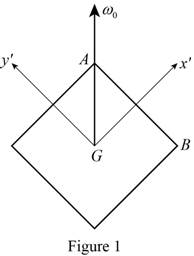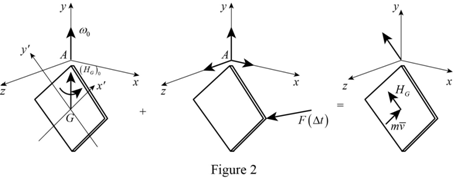
Concept explainers
The kinetic energy (U) lost when plate hits the obstruction at B.
Answer to Problem 18.52P
The kinetic energy (U) lost when plate hits the obstruction at B is
Explanation of Solution
Given information:
The mass of the square plate is m.
The side of a square plate is a.
The angular velocity
Assume the impact to be perfectly plastic that is
Calculation:
Draw the diagram of the system as in Figure (1).

The length of the diagonal of a square is obtained by multiplying the side with
Write the expression for the angular velocity in the
Here,
Write the expression for the angular velocity in the
The unit vectors along the
Write the expression for the initial angular momentum about the mass center
Here,
Write the expression for the moment of inertia in the
Here, m is the mass and a is the side of the square plate.
Due to symmetry, moment of inertia in the
Write the expression for the angular momentum about
Substitute
Calculate the angular velocity at B
Here,
Substitute
The matrix multiplication for vector product is done.
The corner B does not rebound after impact. Therefore, the velocity of B after impact in the
Calculate the angular velocity about the mass center
Here,
Substitute
Substitute 0 for
Write the matrix multiplication for vector product is done.
Write the expression for the angular momentum about A as follows:
Here,
Calculate the angular momentum about G using the formula:
Substitute 0 for
Substitute
The matrix multiplication is done for vector product.
The initial velocity of mass center (
Calculate the initial momentum about A using the relation:
Here,
Substitute
Draw the forces acting on the plate as in Figure (2).

Write the expression for the moment about A as follows:
The matrix multiplication for vector product is done.
Substitute Equation (6) and Equation (7).
Equate
Equate
Equate
Calculate the velocity along the x, y and z axes
Substitute 0 for
Substitute
Calculate the kinetic energy of the system before impact
Substitute 0 for
Calculate the kinetic energy of the system after impact
Substitute
Calculate the loss in kinetic energy (U) using the formula:
Substitute
Thus, the kinetic energy (U) lost when plate hits the obstruction at B is
Want to see more full solutions like this?
Chapter 18 Solutions
Vector Mechanics for Engineers: Statics and Dynamics
- Consider a rigid body initially at rest and subjected to an impulsive force F contained in the plane of the body. We define the center of percussion P as the point of intersection of the line of action of F with the perpendicular drawn from G(a) Show that the instantaneous center of rotation C of the body is located on line GP at a distance GC = k2/GP on the opposite side of G. (b) Show that if the center of percussion were located at C, the instantaneous center of rotation would be located at P.arrow_forwardA long ladder of length l, mass m, and centroidal mass moment of inertia I is placed against a house at an angle 0=0O. Knowing that the ladder is released from rest, determine the angular velocity of the ladder when 0=02. Assume the ladder can slide freely on the horizontal ground and on the vertical wall.arrow_forwardA 240-lb block is suspended from an inextensible cable which is wrapped around a drum of 1.25-ft radius rigidly attached to a flywheel. The drum and flywheel have a combined centroidal moment of intertia of 10.5 lb-ft-s^2. At the instant shown, the velocity of the block is 6 ft/s directed downward. The bearing at A as a frictional moment of 60 lb-ft. What is the kinetic energy of the system after the block moved after 4ft? (in ft-lb)arrow_forward
- A disk with mass m and radius R is released from rest at a height h and rolls without slipping down a ramp. What is the velocity of the center of the disk when it reaches the bottom of the slope? (Hint Use the work-energy principle. At each instant the disk rotates around the contact point C, thus the inertia used for rotatonal kinetic energy should be computed around point C not point G.) m C harrow_forwardA large 3-lb sphere with a radius r = 3 in. is thrown into a light basket at the end of a thin, uniform rod weighing 2 lb and length L= 10 in. as shown. Immediately before the impact, the angular velocity of the rod is 3 rad/s counterclockwise and the velocity of the sphere is 2 ft/s down. Assume the sphere sticks in the basket. Determine after the impact (a) the angular velocity of the bar and sphere, (b) the components of the reactions at A.arrow_forwardA drum with a 500-mm radius is attached to a disk with a radius of 250 mm. The disk and drum have a combined mass of 5 kg and a combined radius of gyration of 350 mm. A 12 kg block D is suspended by a wire that is warped around the drum. Another force P 100 N is applied to the wire that is warped around the disk. If the system is released from rest, neglecting the effect of axle friction determine: * (a) the acceleration of the block and support reactions at C * (b) the velocity of the block and the distance travelled by the block after 5 second * (c) the revolution by the drum just after 5 second. S00 mm P+ 250 mm Aarrow_forward
- A driver starts his car with the door on the passenger’s side wide open ( _ θ = 0). The 100-lb door has a centroidal radius of gyration k = 12 in. and its mass center is located at a distance r = 20 in. from its vertical axis of rotation. Knowing that the driver maintains a constant acceleration of 4 ft/s2 , determine the angular velocity of the door as it slams shut (θ = 90°).arrow_forwardThe double pulley shown has a weight of 35.0 lb and a centroidal radius of gyration of 5.0 in. Cylinder A (25.0 lb) and block B (16 lb) are attached to cords that wrap around pulleys in the manner shown. The coefficient of kinetic friction between block B and the surface is 0.25. Knowing that the system is released from rest at the position shown (h = 4 ft), determine the velocity of cylinder A when it strikes the ground. 6 in. A h 10 in. Barrow_forward2) A slender uniform 30 kg bar is hinged off center and swings down on a vertical plane. In the configuration shown the angular speed of the bar is @ = 2 rad /s?. Knowing that the length of the bar is = 8m, the mass moment of inertia about the center of mass G is IG = mbl² 1 12, and the distance between G and O equals 2m, determine the force at the smooth hinge O. 30°arrow_forward
- 5. Fig. 3 shows the overhead view of a uniform thin rod of length I and mass M that can rotate freely about a fixed axis on a horizontal surface. The rod is at rest initially with moment of inertia MI². A bullet of mass m is fired towards one end of the rod with initial velocity v. After piercing the rod, the bullet's velocity is reduced to v. The angular velocity of the rod after being shot through is ( ) 3mv А. 2ML 7mv В. 4ML overhead view mv C. MI Fig 3 D. 5mv 3MIarrow_forwardA massive sphere, with 10,0cm radius and moment of inertia I=4,00 x 10-3 kg-m² in relation to a straight line passing through the center of mass, rolls without sliding, descending a surface with an inclination of 30º in relation to the horizontal. In a certain initial position the total kinetic energy of the sphere is 17.5j . a Sketch the physical situation by identifying all the forces acting on the sphere in the initial position. (b) How much of this initial kinetic energy is due to rotation? (c)arrow_forwardThe 30-kg turbine disk has a centroidal radius of gyration of 175 mm and is rotating clockwise at a constant rate of 60 rpm when a small blade of weight 0.5 N at point A becomes loose and is thrown off. Neglecting friction, determine the change in the angular velocity of the turbine disk after it has rotated through (a ) 90°, (b ) 270°.arrow_forward
 Elements Of ElectromagneticsMechanical EngineeringISBN:9780190698614Author:Sadiku, Matthew N. O.Publisher:Oxford University Press
Elements Of ElectromagneticsMechanical EngineeringISBN:9780190698614Author:Sadiku, Matthew N. O.Publisher:Oxford University Press Mechanics of Materials (10th Edition)Mechanical EngineeringISBN:9780134319650Author:Russell C. HibbelerPublisher:PEARSON
Mechanics of Materials (10th Edition)Mechanical EngineeringISBN:9780134319650Author:Russell C. HibbelerPublisher:PEARSON Thermodynamics: An Engineering ApproachMechanical EngineeringISBN:9781259822674Author:Yunus A. Cengel Dr., Michael A. BolesPublisher:McGraw-Hill Education
Thermodynamics: An Engineering ApproachMechanical EngineeringISBN:9781259822674Author:Yunus A. Cengel Dr., Michael A. BolesPublisher:McGraw-Hill Education Control Systems EngineeringMechanical EngineeringISBN:9781118170519Author:Norman S. NisePublisher:WILEY
Control Systems EngineeringMechanical EngineeringISBN:9781118170519Author:Norman S. NisePublisher:WILEY Mechanics of Materials (MindTap Course List)Mechanical EngineeringISBN:9781337093347Author:Barry J. Goodno, James M. GerePublisher:Cengage Learning
Mechanics of Materials (MindTap Course List)Mechanical EngineeringISBN:9781337093347Author:Barry J. Goodno, James M. GerePublisher:Cengage Learning Engineering Mechanics: StaticsMechanical EngineeringISBN:9781118807330Author:James L. Meriam, L. G. Kraige, J. N. BoltonPublisher:WILEY
Engineering Mechanics: StaticsMechanical EngineeringISBN:9781118807330Author:James L. Meriam, L. G. Kraige, J. N. BoltonPublisher:WILEY





